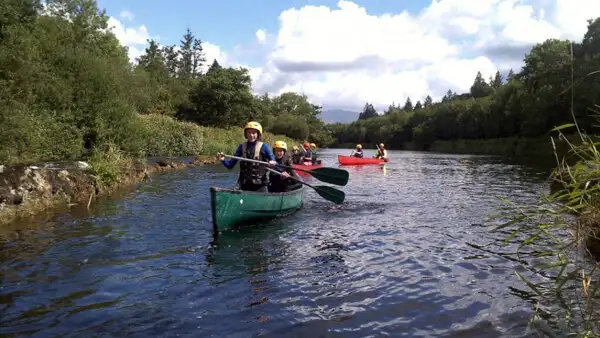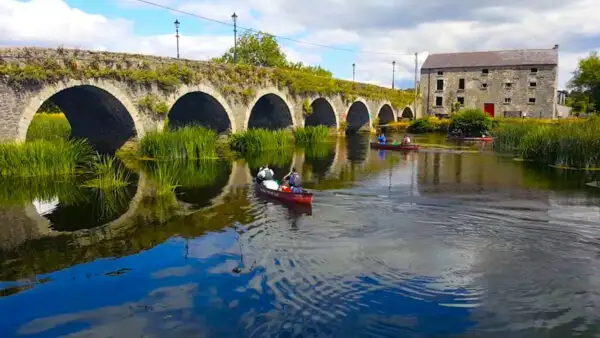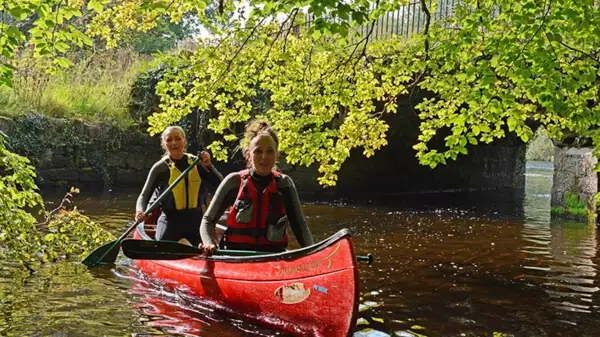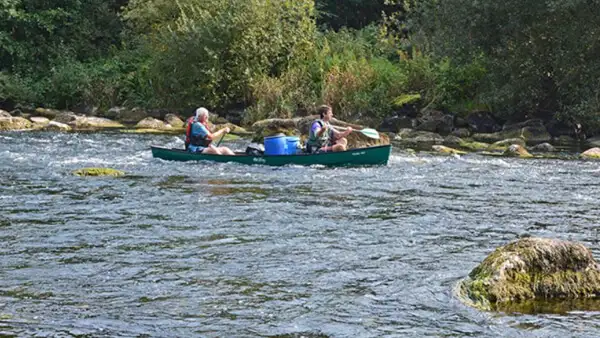Does it make sense to bring the Canadian Canoe to Ireland? It’s so windy there, isn’t it?
The question is quite justified! Canadian Canoes are usually much slower and much more susceptible to wind than touring kayaks.
But let’s take a closer look:
Page Contents (click line to jump the text)

Canoe, Canadian Canoe or Kayak?
For those who don’t know exactly what we’re talking about here, let’s briefly clarify the terms:
The kayak originated in the Arctic regions of North America and Canada. It was a slim, flat and closed boat in which Indian hunters and Eskimos (Inuit) hunted seals and whales on the coast. The paddler did this using a double paddle on both sides.
Everyone knows the Indian canoe from western movies, right? In Germany, where I come from, this is called a “Kanadier” or Canadian Canoe now, maybe because it was used in Canada a lot. In the US this is often just called a Canoe an in your country it may have a different name – just think of the Indian Canoes and you know what I mean. You paddle it with one paddle on one side (mostly).
“Kanu” (in German language) or Canoe is today often used as the generic term for both paddle boats, so it means both, the Kayak and the Canadian Canoe. So canoeists are simply paddlers – no matter what.
Features of the kayak
Modern kayaks come in all sorts of varieties, including open-top and two- or three-person kayaks.
Touring kayaks, however, are still mostly slim, long, enclosed boats that are moved with a double paddle. The slim hull and double paddle make them quite fast.
And the flat design offers little resistance to the wind. When it gets wavy, like on a big lake, in whitewater, or on the coast, the enclosed boat with spraydeck offers the rider and equipment protection from the water.
Features of the Canadian Canoe
The Canadian Canoe often has a raised bow and stern. The side of the boat usually rises higher out of the water than a kayak. Since the Canadian has always been a transport and cargo boat, it has a lot of storage space.
The hull is usually long but also wide and paddled with a paddle on one side. Ideally, the canoe is moved by at least two people. One paddles in front and one behind – then one can paddle on the left and one on the right and it is easier to keep the boat on course. The rear paddler also steers the boat with the paddle.
There are also one-person canoes that can be paddled by one person with a little practice.
Due to the wide bottom, the canoe is very stable in the water and the spacious hull is ideal for stowing extensive camping equipment. If you are traveling with a dog or children, you will find Canadians with plenty of space for the whole family.
So for a camping vacation with several people at the lake or river, the Canadian is excellent. Because it is very stable in the water, this is also a very safe boat even for less experienced paddlers.
You can of course paddle the Canadian on a quiet coast, but on inland waters it is in its true element.

Canoeing in Ireland – Wind and Weather
The Canadian is comparatively slower and offers more attack surface to the wind than a kayak. An open sea with decent gusts is already a challenge for kayakers and even more difficult and tedious to navigate for Canadian drivers.
And therein lies the problem: Ireland is an island and it regularly gets very windy there!
So is the Canadian not a boat for Ireland?
I wouldn’t give it up that quickly. In the winter months, from fall to spring, strong winds and violent storms move across the island.
How do I know that? We have had our second home in Ireland for several years now. Since we have traveled the Irish island many times, we know it well – and the weather too.
I would perhaps not necessarily go to Ireland with the Canadian in spring or autumn and certainly not in winter.
In summer, strong winds and rain are much rarer. Sometimes a low pressure area can move across the Atlantic and bring wind and rain, but usually these are short intermezzos.
You don’t like our weather? Then wait 20 minutes!
Would I give up a two-week canoeing vacation on the River Shannon because of that? Certainly not!
And with that we already have the transition to the next topic…
Suitable areas in Ireland for paddling with a canoe
Where is the best place to paddle a canoe in Ireland?
The Canadian Canoe is rather slow – so why not choose rivers with a current that supports paddling a bit?
The River Barrow has a good current, but is easily navigable with the Canadian. It’s better to skip the weirs, but there are also small locks and if necessary you can also portage around them. On the shore there are towpaths, today hiking trails, which make this possible without any problems. Wild camping is also tolerated there.
The River Shannon is a classic for boating vacations of all kinds. The big lakes, like Lough Ree and Lough Derg, are better left out, or only navigated in moderate winds. But you have many kilometers of river at your disposal where you can paddle and camp beautifully. I would prefer the upper reaches, there the river is even narrower and there are nice smaller lakes along the way.
Just over the border with Northern Ireland you will find the River Erne system, with the lakes Upper Lough Erne and Lower Lough Erne. Lower Lough Erne has a large open water area, but Upper Lough Erne is a paddler’s paradise with lots of little islands that give windbreaks and are great for camping. You won’t have as much helpful current there, but you’ll still do well because of the islands. For a little inspiration, check out this video on Youtube: “Canoe & Camp on the islands of Upper and Lower Lough Erne”.

In Northern Ireland you will find the River Bann, which drains the large Lough Neagh to the north coast. The big lake I would only go by canoe in good weather, but on the idyllic river you will do well.
I would also take a closer look at the canals, where you have little current, but are mostly quite protected by the canal banks. By the way, we are talking about narrow and idyllic canals without transport ships on which today mainly houseboats drive and much paddling is done. The towpaths on the banks have already been largely developed into long-distance bicycle paths. So you can pack a bike into the canoe and row back at the end of the paddle to catch up with the car – cool?
The Royal Canal connects Dublin to the upper, northern part of the River Shannon, while the Grand Canal connects Dublin to the lower, southern part of the River Shannon.
And if the weather is nice and calm during your vacation, you don’t have to limit yourself at all, you can paddle on many more beautiful lakes.
Which Canadian Canoes are recommended for a trip to Ireland?
You already have a Canadian Canoe? Then you can load it up and skip this part. If you’re still looking to get a travel-worthy Canadian, here are a few more tips for you:
There are bulky family canoes with very high bow and stern. This looks very “Indian-like”, but is impractical in Ireland because of the windy conditions. Better suited are canoes with flatter superstructures and not too high sides.
You should pay attention to the load capacity of the boat: If you drive a three-person canoe alone, it will rise high out of the water like a sail! Even two light persons without luggage are then not optimal. Conversely, the small excursion boat may already be too heavily loaded with camping luggage. So find a boat that fits your needs in payload and luggage volume.
Length runs, width brakes. Even if you are not in a hurry, it helps a lot on tour if the boat is easy to drive. Look at the lengths and widths of the possible candidates and choose a slimmer model.
A little tip about the paddle: You can perhaps also use a double paddle on a narrow single canoe and make faster progress? Above all, you avoid too one-sided strain on the upper body.

Inflatable boat, folding boat or rigid hull boat? Which is better?
In recent years, a lot has been done in this area and today there are great air canoes that are driven with high air pressures and therefore have stable hulls and good driving characteristics. High quality inflatable boats are easy to stow in the trunk, are quick to set up and still ride nice and straight and relatively nippy. However, they are usually high in the water and therefore quite sensitive to wind. Examples: Gumotex Scout or Gumotex Palava, Grabner Adventure SL.
Inflatable boats made of dropstitch material are much stiffer and allow more sophisticated hull shapes with slimmer bow and stern sections. They are made of similar materials to SUPs (stand-up paddleboard). They often have better straight-line stability and are slightly faster than traditional inflatable boats. In exchange, they are often heavier. Examples: Decathlon Itiwit canoe x500, Vesano Kandier 14.
Folding canoes with inner frame and outer skin usually have even more stable hulls and are therefore faster. They can also be transported well in the trunk. However, the assembly usually takes considerably longer. If you want a snappy touring boat, they’re great, but if you’re always stopping somewhere to do a little paddling, inflatable boats are more straightforward. Examples: Ally Folding Canoe 16.5, Pakcanoe 165.
You see more and more folding canoes in origami technique. These have no internal framework and the boat wall is made of plastic panels with honeycomb cores that fold into boat shape in minutes. They ride about the same as conventional folding boats, but are not quite as stiff. Examples: Onak X-Duo,
Fixed hull canoes are particularly stable and fast. However, you can only transport them on the roof rack, where they generate a lot of wind resistance (fuel consumption!). But then they are fast and without further construction in the water. Plastic hulls are also very stable and largely insensitive to grounding. Examples: Liberty 3-seater, Venture Hunter, Venture Ranger, Old Town Peobscot 164.
Conclusion
So, that was a lot of food for thought. I hope I was able to help you a bit with your vacation planning and wish you a very great vacation in Ireland with your “old” or new travel Canoe!
More interesting articles for you
YOUR COMPLETE PACKING LIST FOR A HIKING PADDLING TOUR ON IRELAND’S INLAND WATERS
WHERE CAN I GO FOR A HIKING-PADDLING TRIP IN IRELAND – BY KAYAK ON THE INLAND WATERS OF IRELAND
ADVENTURE IRELAND – PACKRAFTING ON THE RIVER BARROW
CAN I FISH FROM A CANOE OR KAYAK IN IRELAND?
Cover photo credit: photo by Portij on Unsplash